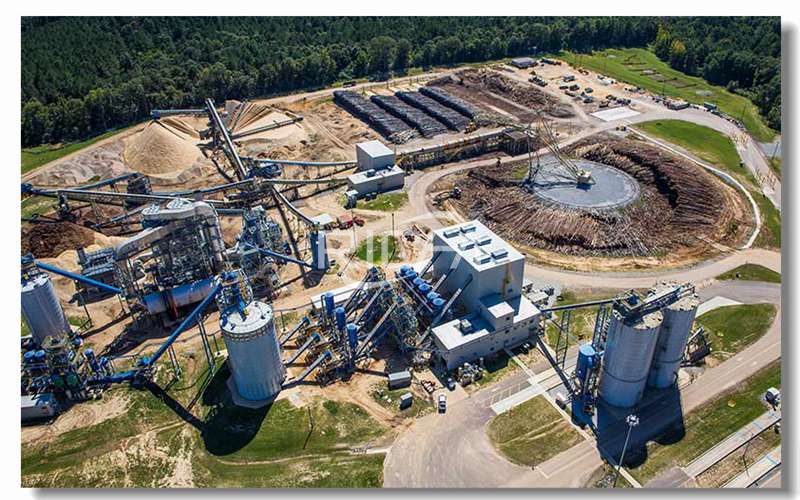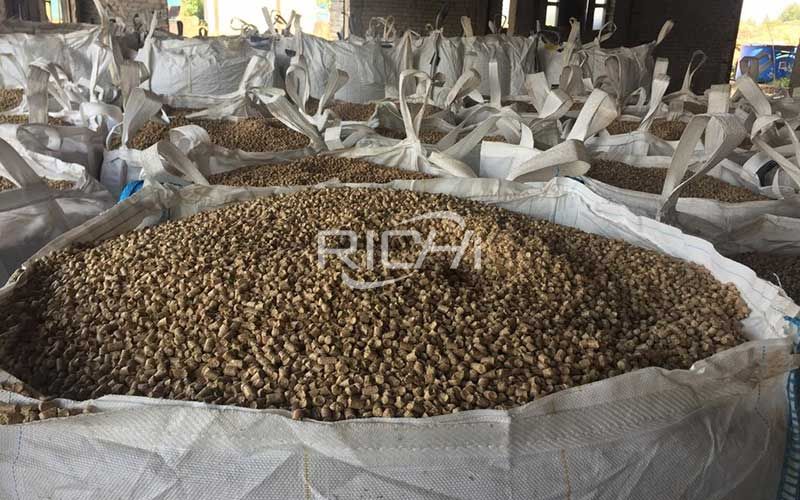
This is where you find all our press releases and news articles.
33 tons/hour biomass wood pellet production line construction project, the annual operation days of the project is about 300 days, 10 hours a day, purchase 8 biomass pellet machine, an average of 4 tons/hour per pellet machine. The biomass fuel produced by this project is a solid fuel produced by extruding wood chips and rice husks from waste wood and furniture factories in Lanxi area. It is easy to store, transport, easy to use, and does not have any harmful additive combustion efficiency. High, clean and environmentally friendly, it can be used for civilian purposes and can replace coal as fuel for industrial boilers. After the project is completed and put into production, it will solve the reuse of waste materials such as chaff waste, increase employment, protect the environment, and promote local economic development. It has good economic and social benefits.

33 Tons/hour Biomass Wood Pellet Production Line Construction Project
Table 1-1 List of project composition
| Engineering composition | Construction Content |
Remarks |
||
| structural work | Wood Biomass pellet fuel production line with a design capacity of 100,000 tons/year |
The building area is 4000m2 |
New |
|
| Auxiliary engineering | Office building |
1 1F, board room structure, construction area of 100m2 | New |
|
| Public works |
Water supply system | The living water source of the project is urban tap water, which is provided by the Lanxi Town Water Plant through the pipe network. | built |
|
| Drainage system |
The rain and sewage diversion system is adopted. Domestic sewage is treated by the granular rice industry septic tank and used for irrigation of surrounding farmland. | |||
| Power Systems | Provided by Lanxi Town Power Grid. | |||
| Environmental Engineering |
Wastewater treatment | Domestic sewage is treated by the granular rice industry septic tank and used for irrigation of surrounding farmland. | / | |
| Waste gas treatment |
Dust from the production processes employed granulator comes baghouse dust; by strengthening the vehicle to reduce the concentration of contaminants between the ventilation plant, production management on workshop. |
New |
||
| Noise control | Use low-noise equipment and take measures such as vibration reduction and sound insulation. | / | ||
| Solid waste treatment |
The dust collected by the dust collector is reused in the granulation process; unqualified products are reused in the granulation process; the sanitation department of household waste is collected and processed in a unified manner. | / |
||
| Storage and Transportation Engineering | The project has a finished product stacking area and a raw material stacking area, with building areas of 500m2 and 2500m2 respectively, and the raw and auxiliary materials are transported by road. | / |
||
| Relying on engineering |
Yiyang Waste Incineration Power Plant |
Yiyang Waste Incineration Power Plant is located in Qingshan Village, Xielingang Town, Yiyang City, Hunan Province. The scale is determined to be 800t/d (365d/a) of waste into the plant, 700t/d (333d/a) of waste into the furnace, and mechanical furnace The furnace incineration process covers the main urban area of Yiyang City and some surrounding towns and towns and the new eastern district. |
||
Table 1-2 Consumption of main raw and auxiliary materials
| Serial number | Name of raw materials | unit | Quantity | source | specification | Storage method | Maximum storage capacity | Remarks |
| 1 | Chaff | 3,000 tons/year | 3 | Outsourcing | Shell-like | Warehouse stacking | 20t | / |
| 2 | Waste wood and sawdust | 7,000 tons/year | 7 | Outsourcing | / | Warehouse stacking | 20t | / |
Table 1-3 List of main production equipment
| Serial number | Equipment name | model | Quantity | unit | Energy consumption | Remarks |
| 1 | wood pellet machine | MZLH858 | 8 | station | Electricity | / |
| 2 | conveyor | 12m | 1 | Article | Electricity | / |
| 3 | Sieve | TSL125 | 2 | station | Electricity | |
| 4 | Forklift | / | 2 | Vehicles | Diesel | Don't save |
| 5 | transformer | / | 1 | station | Electricity | |
| 6 | Fan | 4-72N06a | 8 | station | Electricity | / |
Table 1-4 Main products and scale
| Serial number | main products | unit | Yield | specification | package style |
| 1 | Biomass particles | 10,000 tons/year | 10 | 25kg/bag | Bagged |
Raw and auxiliary materials entering the factory: The raw and auxiliary materials used by the company are waste wood, wood chips and chaff. Wood needs to be crushed into small wood chips with a drum chipper, and then crushed into wood chips with a hammer mill.
Screening: The raw material sawdust and chaff are screened to remove other impurities such as stones in the chaff.
Granulation: The sieved sawdust and rice husk are formed in a wood pelletizer through a conveyor belt, and heated by the pelletizer's own equipment. The temperature of the wood chips and chaff can reach 80℃ to 90℃, and the pellets are extruded. The fuel is continuously extruded to the outer end of the die hole, and the shaped particles are cut into the required length by the cutter, and finally the shaped particles flow out of the pelletizer and fall into the product conveyor.
Cooling: The temperature of the pellets is as high as 80-90℃ when the pelletizer is discharged, and must be cooled to room temperature before being put into storage. This project adopts wind cooling. Since the biomass particles have been compressed and dense, there is basically no dust generated during the cooling process.
Screening and storage: The cooled biomass particles are sent to the finished product warehouse by a conveyor. The conveying equipment is equipped with a sliding screen. The particles that meet the required size enter the finished product warehouse, and the non-compliant biomass particles fall into the lower layer of the screen. It is discharged before entering the finished product warehouse and reused in the granulation process. Qualified biomass particles fall into the finished product warehouse, and the bottom of the finished product warehouse is a funnel-shaped discharge port, which is pneumatically discharged. The finished product can be directly dropped into the packaging bag and packaged with a baler before being sold. The formed biomass particles have been compressed and compacted, and there is basically no dust during the bagging process. After the unqualified products are discharged, they return to the forming process.

Biomass Wood Pellet
The annual operation days of the project are about 300 days, 10 hours a day, and the labor force of the project is 15 people. There is no staff canteen and dormitory in the factory.
Having the right mix of reliable, high-quality pellet machine and pelletizing systems and expert support is essential to your success. Watch how our end-to-end feed pellet plant solutions have helped our customers optimize their performance.
Our customized and future-proofed turnkey pellet plant solutions is designed with you at the core. From vision to reality and beyond, our team stays connected with yours. Giving you peace-of-mind with an expert at your side.

At RICHI, we go beyond project completion. With RICHI Servicee, we’re your dedicated partners in success. Count on us for expert guidance, minimal downtime, and optimized productivity. Choose RICHI for unmatched service and support.



Meet global product demands and quality standards with industry-leading pellet plant design, engineering, equipment, and construction services for pellet processors.


Your Partner Beyond Project Completion
2000+ cases
RICHI is the leading designer, manufacturer and builder of pellet plants in the world, completing over 2000 projects in 140 countries across 6 continents.
Read More
Increase plant productivity, profitability, and safety by integrating high quality equipment into your pellet production line. Over the years, RICHI has become China's top pellet equipment manufacturer. At the same time, RICHI has established valuable partnerships with the world's leading component and raw material manufacturers to bring you the best there is in technology, automation, and efficiency in pelleting plant machinery.

For nearly 30 years, RICHI has been providing best-in-class pellet plant equipment and services to clients across a variety of industries, sizes, and needs. We pride ourselves on the knowledge and skill that each team member possesses – from our technical sales team to our process design engineers. You can count on RICHI Machinery to take your operation to the next level of innovation, quality, and success.
Need help with your pellet manufacturing plant project? Contact us today.
ANIMAL FEED
BIOMASS
WOOD
ORGANIC FERTILIZER
AQUA FEED
CAT LITTER
MUNICIPAL WASTE RECYCLING
SPECIAL PELLET PRODUCTION
RICHI Machinery continues to deliver world class pellet mill equipment, pellet plant engineering and project solutions that add value to our customers in the animal feed, wood waste, agriculture waste, organic fertilizer, cat litter and special pellet products industries. Throughout the years, we RICHI Machinery have built strong brand, becoming industry-leading pellet machine manufacturer. We value integrity, promise quality, and prioritize your success.
Learn MoreWith our expert team, we precisely implement your process engineering requirements in pellet mill and pelletizing plant systems. No matter which industry you’re in – we understand your needs and deliver solutions that meet the highest standards.
At RICHI, quality comes first. Our pellet making machine and related pellet line equipment undergo rigorous quality controls to ensure they meet the highest standards. Rely on products that are durable, safe, and efficient.
With decades of experience in pellet machine and pellet production line production, we have earned a reputation as a trusted partner in various industries. Our expertise allows us to cover a wide range of applications.
Not only do we offer premium pelleting equipment, but we are also experts at designing, building, installing, and maintaining facilities from the ground up. Our expertise is within pellt plant process design, discovering the most efficient, productive, and profitable way to handle your materials in an end-to-end cycle.

Keeping in touch with us is an effective way to solve all your problems. If you have any needs or questions, please leave your contact information, then RICHI technical consultants will send design, quotation, videos to your mailbox. You can also contact us directly via WhatsApp: +86 13838389622
Copyright©2015-2024 by HENAN RICHI MACHINERY CO., LTD. All rights reserved.